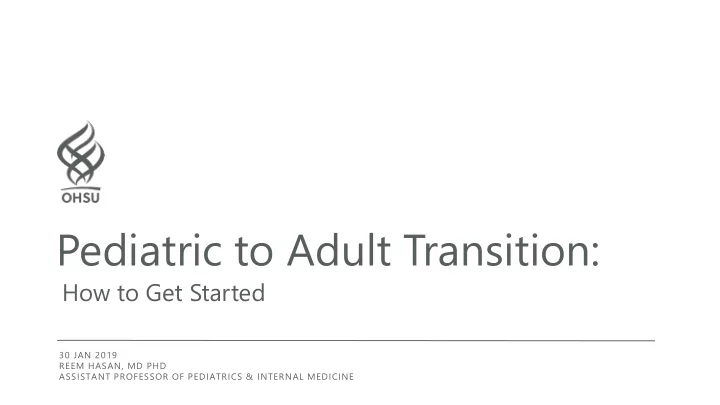

Pediatric to Adult Transition: How to Get Started 30 JAN 2019 REEM HASAN, MD PHD ASSISTANT PROFESSOR OF PEDIATRICS & INTERNAL MEDICINE
Disclosures • I have no relevant financial relationships with the manufacturer(s) of any commercial product(s) and/or provider(s) of commercial services discussed in this presentation. • I do not intend to discuss an unapproved/investigative use of a commercial product/device in my presentation. 2
Objectives • Identify available resources for creating a transition program • Review the Pediatric to Adult Transition (PACT) Starter Kit • Create an outline for your own clinic transition process 3
Background • Adolescents and emerging adults • Period between ages 12-24 • Pediatric model adult model of care – changes in privacy, decision making rights – expectations surrounding clinic support services and patient self-care abilities 4
When? “Six Core Elements of Transition” 5 www.gottransition.org/providers
www.gottransition.org 6 Arthritis & Rheumatology Volume 68, Issue 4, pages 789-794, 28 MAR 2016 DOI: 10.1002/art.39554 http://onlinelibrary.wiley.com/doi/10.1002/art.39554/full#art39554-fig-0001
9
http://oregonfamilytofamily.org 10
Pediatric to Adult Care Starter Kit • Where do I start? • Practical next steps • Modeled on experience at OHSU: – General Pediatrics – General Internal Medicine – Work with Subspecialty clinics 11
1. Build Your Team • Champions are needed • Involve all team members – interprofessional effort 12
2. Set goals and timelines • Many points of intervention – consider when to initiate and follow up with patients • Will depend on clinic bandwidth and priorities • Communication is key 13
3. Decide…. • Which patients to target • How to introduce program to patients • Which health management self-assessment tools • Who will complete a ‘health passport’ 14
Which patients? • Healthy, typically developing adolescent • Adolescent with chronic health condition but no impact on cognition • Adolescent with significant intellectual disability precluding ability to care for self or make independent decisions 15
SHCN 16
How to introduce • Letters, handouts, phone outreach • Face to face visits 17
18
19
Self-assessment tool • Many resources available • Create one that works for you • Consider medical, social, educational, vocational needs 20
21
Health passport • Use as a teaching and organizational tool • Resources available or create your own 22
23
4. Collect resources • Resources available or create your own – Partner with local community organizations • Have a follow up plan for resource gaps 24
25
5. Pilot with 2-5 patients • Assess medical, social, educational, vocational, community, transition resource needs • Consider a QI framework for collecting baseline data and cycles of improvement 26
6. Identify gaps, set goals, create an action plan • Engage the patient! • Decide who will be leading interactions • Assess needs with each patient • Document - consider how to integrate into EHR 27
7. Track and measure • Create a database • Integrate into EHR 28
29
PACT Starter Kit 30
Now it is your turn! • Think about your clinical setting • Take out a sheet of paper and write your next 2 steps – Who to talk to, who is your team? – Where will you collect resources? – What baseline information will you collect? – What can you start trialing next week? 31
Summary • Process can seem overwhelming – Lots of steps – Lots of variables • Start the process early (age 12-14) • Bring a group together and start with your ideas 32
Review Objectives • Identify available resources for creating a transition program • Review the Pediatric to Adult Transition (PACT) Starter Kit • Create an outline for your own clinic transition process 33
General Pediatrics Transition Team Belen Estrada Lisa Johnson Lorraine Koepsell Reyna Lindert Nicole Ripsom Mary Smith Thank You OHSU Transition Task Force Marilyn Berardinelli Andrea Frank hasanr@ohsu.edu Julie Johnson Kim Solondz
Recommend
More recommend